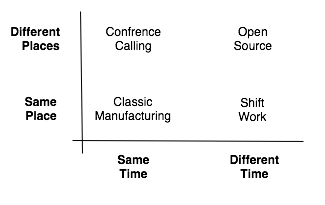A friend recently shared with me a paper from the dark ages (i.e. 15-20 years ago) on the changing nature of work and the tools people were hacking up to support these bizzare new forms of work.
It had a chart like this one; except that I’ve put some points on the chart.

That’s the kind of chart that B School professors can make an entire consulting practice out of.
One of the things I’ve been noticing recently is that the locus of work is moving toward the upper right hand corner. The folks working on a given peice of collective action rondevous less and less in time or space, sometime never. Other points of rondevous are replacing those; e.g. the code repository, the mailing list, etc.
Some kinds of work are stuck in the lower corner. For example the Congress only lets those people in the room at the time vote; so they are stuck having to all be in the same place at the same time.
I sat on a board of directors once. The lawyers wouldn’t let us hold our board meetings in the upper right corner and insisted that we do them on the phone. The phone thing was still pretty innovative.
As you move around in this space you encounter different practices. For example a group of graphic designers working in the lower left will sketch and toss bits of paper back and forth across the table. Once there work moves away from there they loose that; which makes them sad. But it begins to allow practitioners that don’t excell at rapid interaction to join in.
I’m convinced that lots of people and groups are very confused about all this. If some of the players moves to one point in the space and some of the players stay in another part of the space it provides all the raw materials for boundry making and conflict.
More interestingly I’ve seen situations where the work moved into the upper right while some number of people clinge to the lower right – staying in their comfort zone – so that the community is paying the cost of supporting two complete infrastructures for coordinating work.
That’s similar to the way that if you want to introduce the next generation standard you need to inter-operate for a very long time. Thus televisions are still ready and willing to recieve a black and white signal, my office has a fax machine, a mail room, and the old office had a hitching post outside.